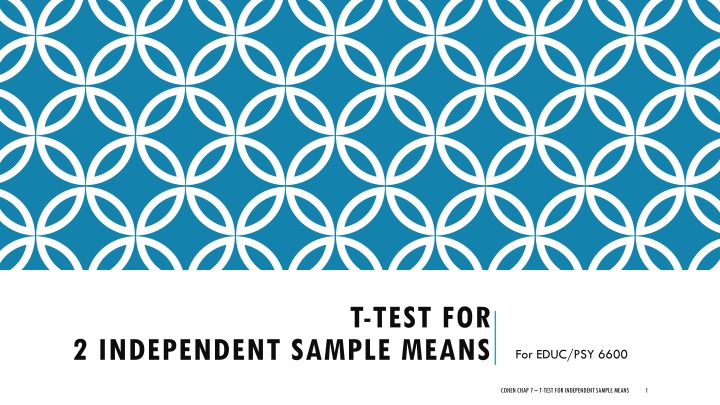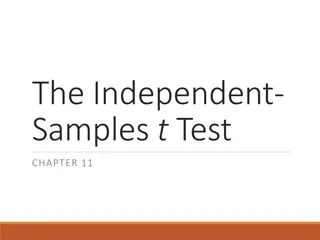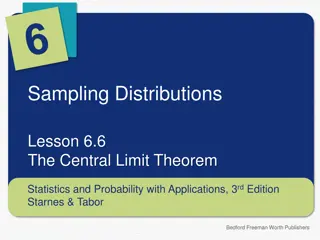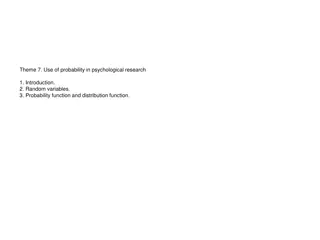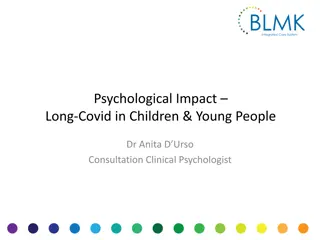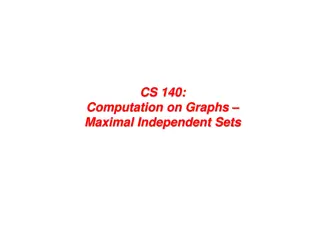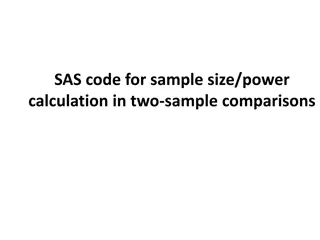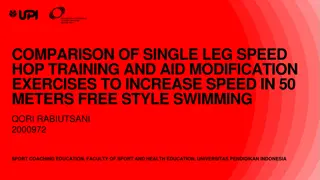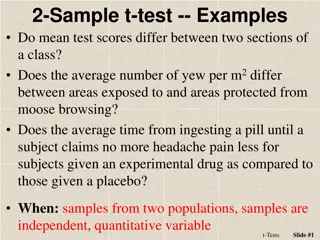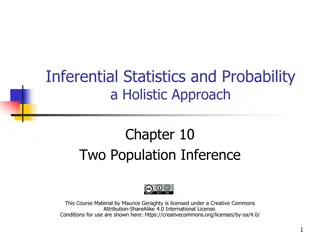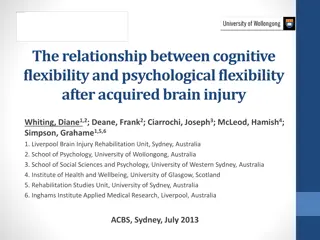Introduction to Independent Sample Means T-Test in Educational and Psychological Research
Independent Sample Means T-Test is a statistical analysis used to compare the means of two independent groups to determine if there is a significant difference between them. This test is commonly used in educational and psychological research to assess the effectiveness of interventions or treatments. The process involves formulating hypotheses, selecting the appropriate statistical test, collecting data from random samples, calculating the test statistic, and making a statistical decision based on the results. The test is useful for investigating if two groups come from different distributions with the same mean.
Download Presentation

Please find below an Image/Link to download the presentation.
The content on the website is provided AS IS for your information and personal use only. It may not be sold, licensed, or shared on other websites without obtaining consent from the author.If you encounter any issues during the download, it is possible that the publisher has removed the file from their server.
You are allowed to download the files provided on this website for personal or commercial use, subject to the condition that they are used lawfully. All files are the property of their respective owners.
The content on the website is provided AS IS for your information and personal use only. It may not be sold, licensed, or shared on other websites without obtaining consent from the author.
E N D
Presentation Transcript
T-TEST FOR 2 INDEPENDENT SAMPLE MEANS For EDUC/PSY 6600 COHEN CHAP7 T-TEST FOR INDEPENDENT SAMPLEMEANS 1
WE CANNOT SOLVE PROBLEMS BY USING THE SAME KIND OF THINKING THAT WE USED WHEN WE CREATED THEM. Albert Einstein COHEN CHAP 7 T-TEST FOR INDEPENDENT SAMPLE MEANS 2
INTRO Same continuous DV compared across 2 independent (random) samples Is there a significant difference between the 2 group means? Do 2 samples come from different normal distributions with the same mean? aka Independent-groups design Between-subjects design Between-groups design Randomized-groups design COHEN CHAP 7 T-TEST FOR INDEPENDENT SAMPLE MEANS 3
STEPS OF A HYPOTHESIS TEST ?0:?????= 0 ?1:????? 0 ?1 ?2= 0 ?1 ?2 0 ?1= ?2 ?1 ?2 ??? ?? ????? T-Test Statistic : ? = 1) State the Hypotheses (Null & Alternative) *even use z, if N > 100 ish 2) Select the Statistical Test & Significance Level level One vs. Two tails 3) Select random samples and collect data 4) Find the region of Rejection Based on & # of tails 5) Calculate the Test Statistic Examples include: z, t, F, 2 6) Make the Statistical Decision 4
Separate Variance t Separate Variance t- -Test (need HOV) Test STEPS OF A HYPOTHESIS TEST ?1 ?2 ?1 ?2 ?12 ?1 +?22 ? = ?2 1) State the Hypotheses (Null & Alternative) 2) Select the Statistical Test & Significance Level level One vs. Two tails ??? ?1,?2 1 < ?? < ?1+ ?2 2 Pooled Pooled- -Variance t Variance t- -Test (different sample sizes) Test 3) Select random samples and collect data ?1 ?2 ?1 ?2 1 ?1+1 4) Find the region of Rejection Based on & # of tails ? = ??2 ?2 5) Calculate the Test Statistic Examples include: z, t, F, 2 ?? = ?1+ ?2 2 ?? 6) Make the Statistical Decision ?2= ? 1 ??1+ ??2 ?1+ ?2 2 ??2=
EXAMPLE 1 In order to assess the efficacy of a new antidepressant drug, 10 clinically depressed participants are randomly assigned to one of two groups. Five participants are assigned to Group 1, which is administered the antidepressant drug for 6 months. The other 5 participants are assigned to Group 2, which is administered a placebo during the same 6 month period Assume that prior to introducing the treatments, the experimenter confirmed that the level of depression in the 2 groups was equal After 6 months, all participants are rated by a psychiatrist (blind to participant assignment) on their level of depression 7
EXAMPLE 1 T-TEST COHEN CHAP 7 T-TEST FOR INDEPENDENT SAMPLE MEANS 10
EXAMPLE 1 After 6 months, the five participants taking the drug scored numerically lower on the depression scale (M = 2.80, SD = 4.66), compared their five counter parts taking placebo (M = 7.80, SD = 3.27). To test the effectiveness of the drug at reducing depression, an independent samples t-test was performed. The distribution of depression scores were sufficiently normal for the purposes of conducting a t-test (i.e. skew < |2.0| and kurtosis < |9.0|; Schmider, Sigler, Danay, Beyer, & Buhner, 2010). Additionally, the assumption of homogeneity of variances was tested and satisfied via Levene sF-test, F(1, 8) = .08, p = .782. The independent samples t-test did not find a statistically significant effect, t(8) = -1.796, p = .110. Thus, there is no evidence this drug reduces depression. 11
ASSUMPTIONS (SIMILAR TO 1-SAMPLE T-TESTS) 1. BOTH Samples were drawn INDEPENDENTLY at random (at least as representative as possible) Nothing can be done to fix NON-representative samples! Can not statistically test violation: paired-samples t-test 2. The variable has a NORMAL distribution, for BOTH population Not as important if the sample is large (Central Limit Theorem) IF the sample is far from normal &/or small n, might want to transform variables Look at plots: histogram, boxplot, & QQ plot (straight 45 line) sensitive to outliers!!! Skewness & Kurtosis: Divided value by its SE & > 2 indicates issues Shapiro-Wilks test (small N): p < .05 not normal Kolmogorov-Smirnov test (large N): 3. HOV = Homogeneity of Variance: BOTH populations have the sample spread use Levene s F-test (null= HOV) 12
RANDOM ASSIGNMENT Random assignment to groups experimenter biases Cases are enumerated Numbers drawn and assigned to group in any of several ways Does not ensure equality of group characteristics Experiment: Random assignment & manipulation of IV Treatment vs. control or 2 treatment groups Quasi-experiment: Either randomization or manipulation Non-experiment: Neither randomization or manipulation Participants self-select or form naturally occurring groups COHEN CHAP 7 T-TEST FOR INDEPENDENT SAMPLE MEANS 13
VIOLATIONS OF ASSUMPTIONS Equal groups: Violations hurt less Heterogeneity of variance Small effects, p-value inaccurate .02 Non-normality Small effects, p-value inaccurate .02 However: If samples are highly skewed or are skewed in opposite directions p-values can be *very* inaccurate Both Moderate effects if Nis large, p-value can be inaccurate Large effects if Nis small, p-value can be *very* inaccurate COHEN CHAP 7 T-TEST FOR INDEPENDENT SAMPLE MEANS 14
VIOLATIONS OF ASSUMPTIONS Unequal groups: Violations hurt more Heterogeneity of variance Large effects Non-normality Large effects Both Huge effects p-values can be **very** inaccurate with unequal ns and violations of assumptions, especially when Nis small COHEN CHAP 7 T-TEST FOR INDEPENDENT SAMPLE MEANS 15
ALTERNATIVES (ASSUMPTIONS VIOLATED) Violation of normality or ordinal DV Two Sample Wilcoxon test (aka, Mann-Whitney U Test) Sample re-use methods Rely on empirical, rather than theoretical, probability distributions Exact statistical methods Permutation and randomization tests Bootstrapping COHEN CHAP 7 T-TEST FOR INDEPENDENT SAMPLE MEANS 16
CONFIDENCE INTERVALS 95% CI for difference between means: 1 - 2 Rearrange independent-samples t-test formula ( ) = /2*( ) CI X X t s 1 1 2 X X 1 2 Estimation as NHST (Null hypothesis Significance Test) If H0: 1 = 2and if CI does NOT contain 0, reject H0 If H0: 1 = 2 and if CI does contain 0, fail to reject H0 Compute for in-class example COHEN CHAP 7 T-TEST FOR INDEPENDENT SAMPLE MEANS 17
EXAMPLE 2 An industrial psychologist is investigation the effects of different types of motivation on the performance of simulated clerical tasks. The 10 participants in the individual motivation sample are told that they will be rewarded according to how many tasks they successfully complete. The 12 participants in the group motivation sample are told that they will be rewarded according to the average number of tasks completed by all the participants in their sample. The number of tasks completed by each participant are as follows: Individual Motivation: Group Motivation: 11, 17, 14, 12, 11, 15, 13, 12, 15, 16 10, 15, 4, 8, 9, 14, 6, 15, 7, 11, 13, 5 group Individual Group n = 10 n = 12 value 13.6 (2.1) 9.8 (3.9) ## data object is df2_long df2_long %>% dplyr::group_by(group) %>% furniture::table1(value) 18
EXAMPLE 2 library(tidyverse) library(furniture) ## our data object is df2_long ## Check boxplots df2_long %>% ggplot(aes(x = group, y = value)) + geom_boxplot() 15 12 value 9 6 Individual Group group COHEN CHAP 7 T-TEST FOR INDEPENDENT SAMPLE MEANS 19
EXAMPLE 2 df2_long %>% car::leveneTest(value ~ group, data = ., center = "mean") #> Levene's Test for Homogeneity of Variance (center = "mean") #> Df F value Pr(>F) #> group 1 4.8287 0.03994 * #> 20 df2_long %>% t.test(value ~ group, data = ., var.equal = FALSE) #> #> data: value by group #> t = 2.9456, df = 17.518, p-value = 0.008833 #> alternative hypothesis: true difference in means is not equal to 0 #> 95 percent confidence interval: #> 1.098587 6.601413 #> sample estimates: #> mean in group 1 mean in group 2 #> 13.60 9.75 Welch Two Sample t-test COHEN CHAP 7 T-TEST FOR INDEPENDENT SAMPLE MEANS 20
#> Levene's Test for Homogeneity of Variance (center = "mean") #> Df F value Pr(>F) #> group 1 4.8287 0.03994 * #> 20 EXAMPLE 2 #> #> data: value by group #> t = 2.9456, df = 17.518, p-value = 0.008833 #> alternative hypothesis: true difference in means is not equal to 0 #> 95 percent confidence interval: #> 1.098587 6.601413sample estimates: #> mean in group 1 mean in group 2 #> 13.60 9.75 Welch Two Sample t-test The number of tasks completed was numerically higher among the individually motivated group (n = 10, M = 13.60, SD = 2.12), compared to the individuals being motivated by the groups results (n = 12, M = 9.75, SD = 3.89). To test the difference in mean productivity, an independent samples t-test was performed. The distribution of depression scores were sufficiently normal for the purposes of conducting a t-test (i.e. skew < |2.0| and kertosis < |9.0|; Schmider, Sigler, Danay, Beyer, & Buhner, 2010). Additionally, the assumption of homogeneity of variances was tested and rejected via Levene sF-test, F(9, 11) = 4.829, p = .040. The independent samples, separate variances t-test found a statistically significant effect, t(17.52) = 2.946, p = .009. Thus, individual motivation does result in a mean 3.85 additional tasks completed compared to group motivation (95% CI: [1.01, 6.60]). 21
